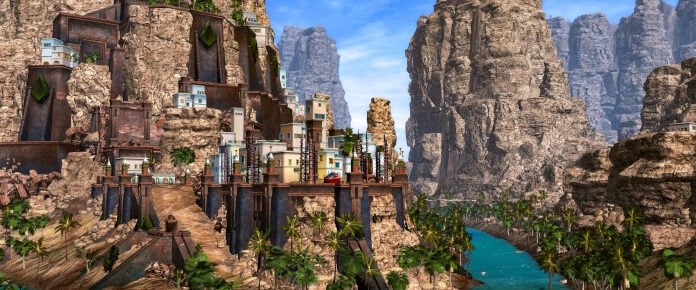
Thanks to the press preview hosted by Thunderful and Sand Sailor, I recently had the opportunity to play around with survival sandbox ASKA a few days before it entered early access. As in most early access games, there’s work to be done to get it to full release. But even the game that’s live now is a fun, engaging, and slow-paced game in a market where everything has you sprinting for the finish. It’s a unique game that’s not quite like anything else I’ve played before, and I’m excited to see how it grows as it moves towards full release.
First things first: ASKA is not Valheim. They are very different games, and the only thing they have in common is “Vikings.” Valheim is a full-on Viking survival-builder, and ASKA is a Viking colony simulation with lightweight survival-builder aspects. Valheim is much more about combat, and ASKA is much more about building. So while they both have elements of building and combat, the focuses for each game are very different.
ASKA is a slow-paced game. While there are mechanics like thirst and hunger, it’s easy to keep up with those needs. It’s low-stress and focused on steady progression and colony management with small periods of combat. I think about it as a mix between Stardew Valley and Oxygen Not Included with a healthy seasoning of Valheim. If you are looking for Elden Ring with Vikings or a game where you can rush to the end and turn the world into a blood-soaked wasteland under your bootheel, this isn’t the game for you.
But if you want something that’s slower-paced, with a big focus on strategic building, villages, and villager management, with some elements of combat to keep things spicy, you might want to give it a try.
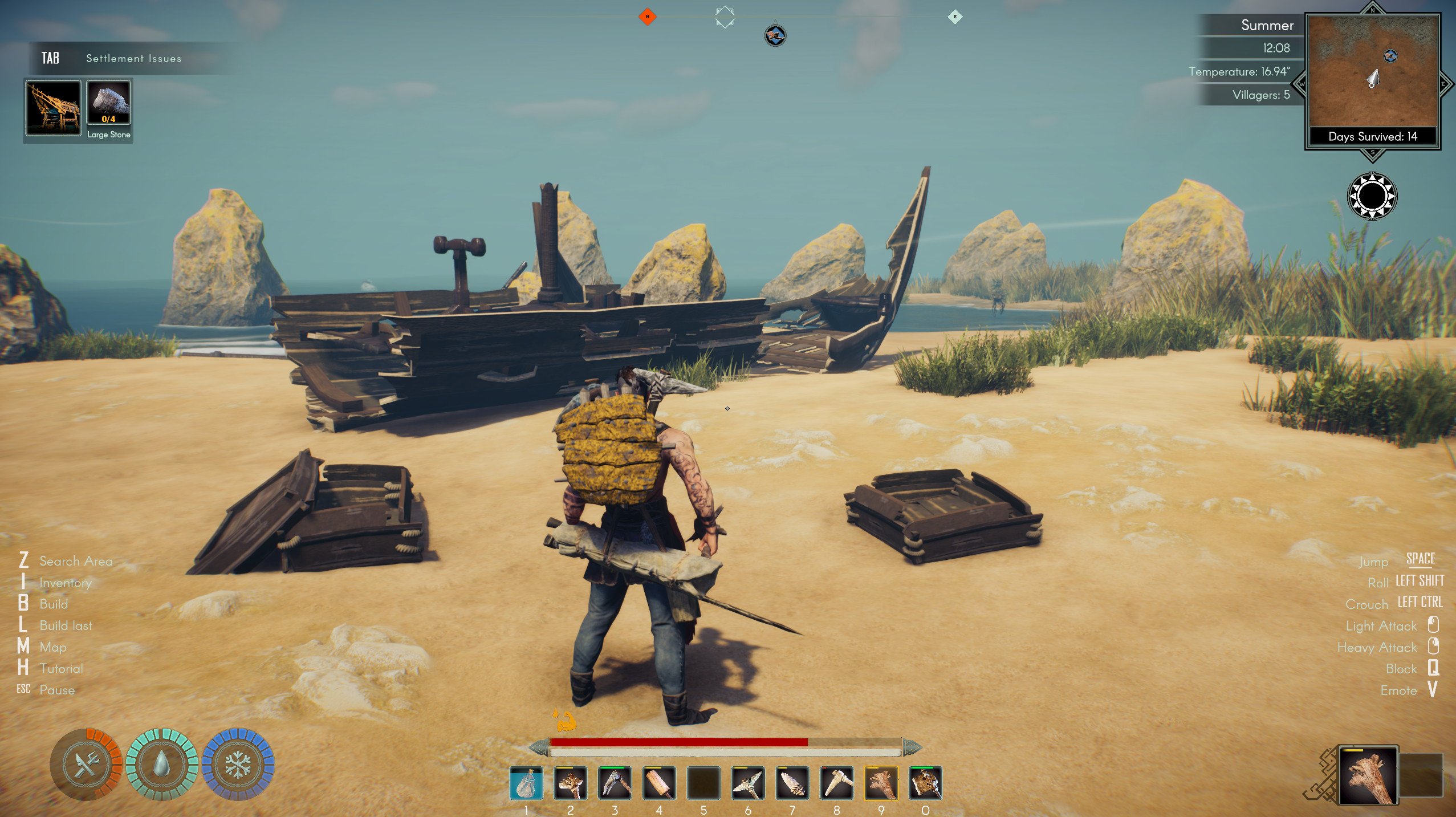
The backstory for ASKA is a little muddled. It’s the standard “people bad, bad things happened to them, and then you wake up shipwrecked on a beach.” I’m not new to either colony sims or survival builders, so I immediately started picking up everything that I could find. ASKA does this wonderful thing: You hit the Z key, and anything you can interact with in the world glows orange and all the environmental foliage shrinks, making it much easier to see and pick up small objects. After a few seconds, the foliage grows back to its normal size.
It’s a small detail and a smaller feature, but one that I found myself grateful for again and again, and that’s a theme I found throughout my playtime with ASKA: It’s loaded with small but high-impact changes that make it easy to glaze over the rough spots that come with every early access game.
As in Valheim, you’ll perform specific tasks — like chop trees, smash rocks, forage for food – to level up specific skills and get better at them. This happens for just about everything you can do in the game, from foraging to building to crafting to fighting.
As it’s a survival game, you’ll have to manage your hunger and your thirst too. You start the game with a full water skin, which gives you five drinks of water. After that, it’s up to you to find more water. Finding water was a bit of a challenge for me at first – so much of a challenge, in fact, that it was the reason that I died my only death.
See, there are special rocks scattered throughout the map called “natural water collectors” that collect rainwater and allow you to refill your water skin. These contain only one drink of water, and when you drink it, you have to wait for it to get foggy or rain for it to replenish. I found one close by, but then couldn’t find any more. It turned out that this was just a quirk related to where I was looking for these rocks. I was focused on the beach where I shipwrecked, and there was only one. However, after I died, I decided to go scampering through the forest a bit further and found they were plentiful pretty much everywhere but where I had started looking.
So now that I’ve established how to not die of thirst, I want to talk about the inventory system, which is quite different from others in similar games, and you will likely either love it or hate it. You have three different sections to your inventory: a small items section, a medium items section, and a large item section. Items in your small items section are things like small stones, fibers, and food items. They stack up to five or ten depending on the item. In your medium items section, these are things like sticks, bark, firewood, tools, things like that. These don’t stack at all, so it’s one item per slot.
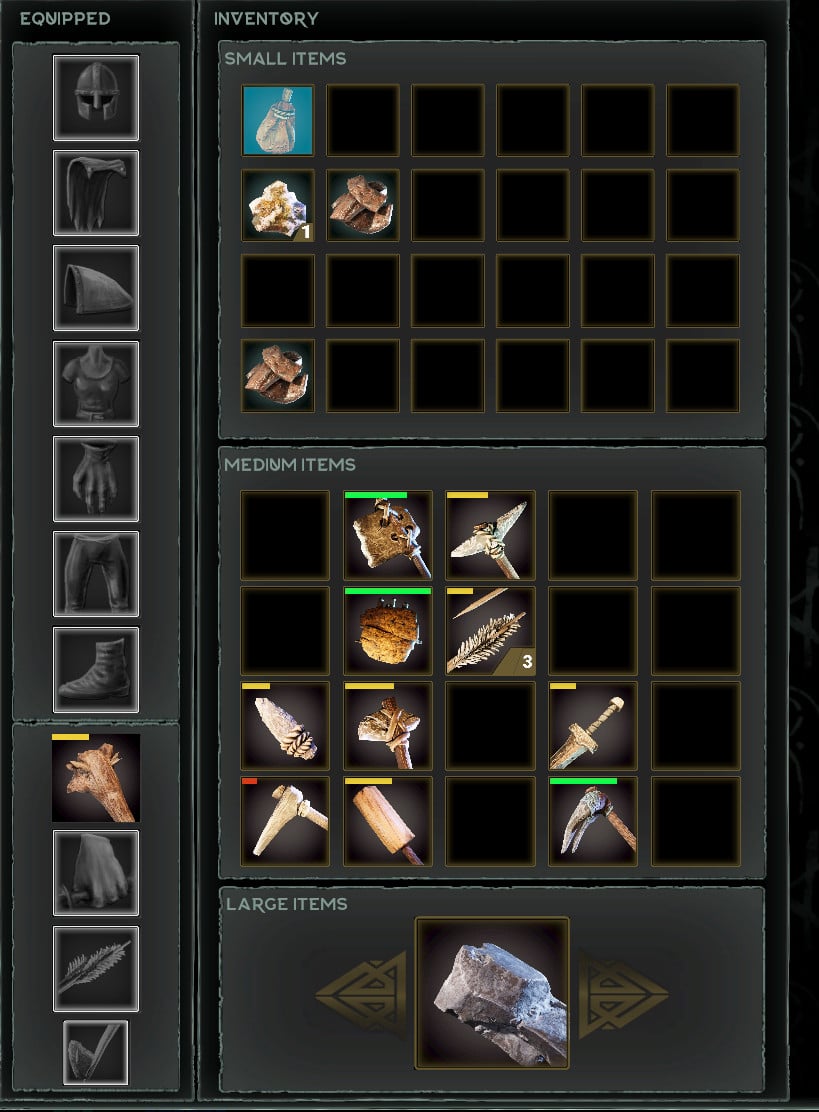
Another one of the small details that I liked is that what’s in your medium inventory shows up on your character. If you are holding a lot of bark, you’ll see pieces of bark on your back. If you are holding sticks, you can see the sticks. It’s a nice detail that I enjoyed but didn’t impact the game at all.
Finally, in your large item section, you have a single slot. You can carry only one large item at a time. Similar to the medium items, these show up on your character when you’re holding them – but it’s because you have to carry them. If you pick up a “long stick,” you hoist it up on your shoulder and carry it to the destination. While you are carrying it, you can’t use your hands for other things like using tools (though you can still pick up small objects).
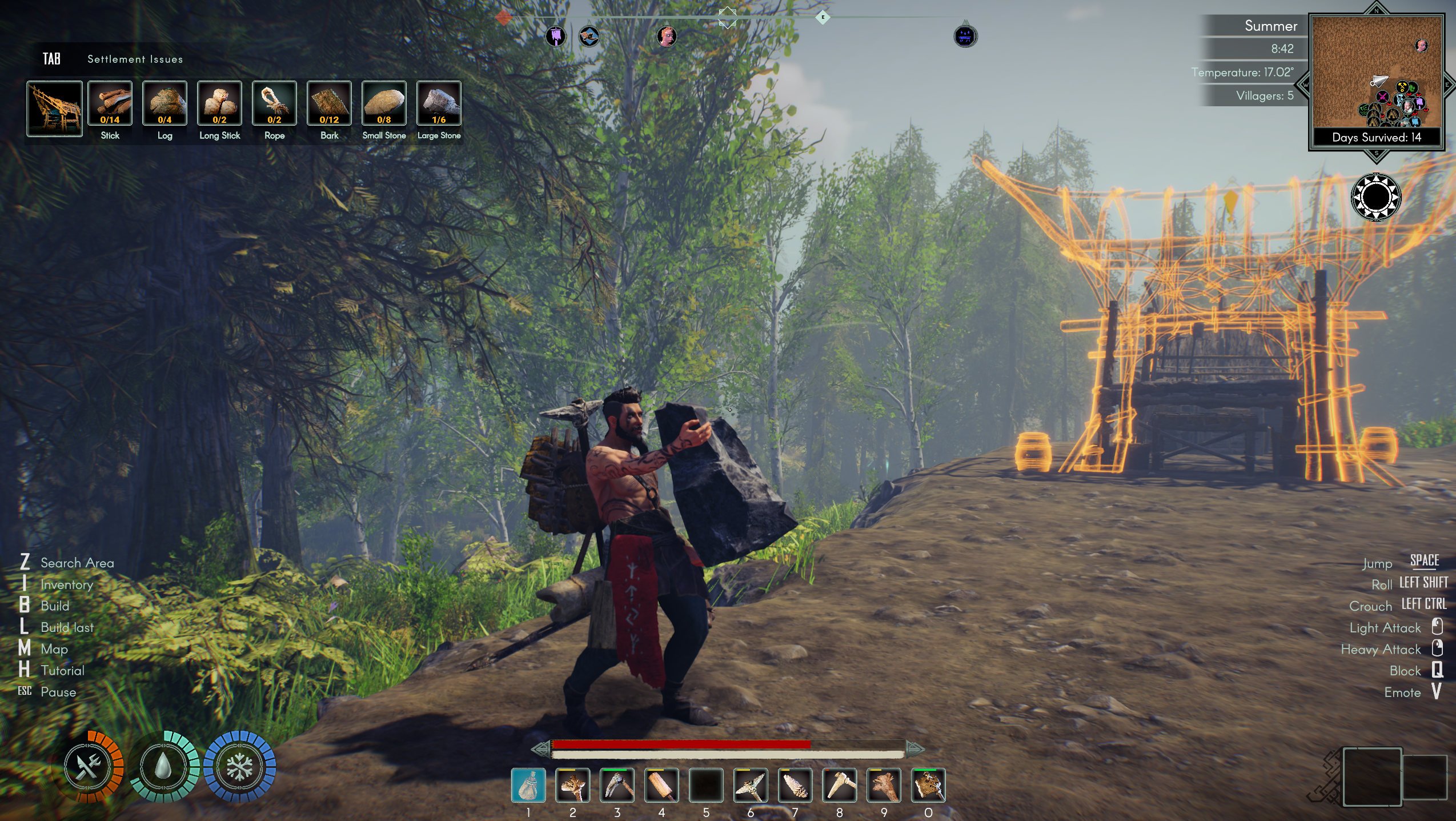
Let’s move on to managing a more meta inventory: your villagers. Once you create your Eye of Odin and pick up 5 Jotun Blood, you can summon your first villager. When you summon a villager, you get a choice between two options, and you can see the first two of five traits that they have. These can be things like “extra good at breaking rocks” or “really hates the cold.” The other three traits are revealed when your villager is completely summoned. The summoning takes 10 minutes per villager, so it takes a bit of time.
Villagers have all the same needs as you do: They need food and drink available, they need tools to be able to harvest for you, they need weapons to fight for you… you get the idea. But they also need shelter, and they get salty if they don’t have a place to sleep (which, like, fair).
Villager management was… fine. Not great. There’s not a lot of explanatory text. For example, once I built a woodcutter pit, I could assign villagers to it. The woodcutter pit is a storage location, and assigning your villagers to the pit means that they’ll head out and start stocking it up for you. What I didn’t realize at first is that they would run around and grab any wood bits you had previously chopped down and stock them. But once they run out of those, they’ll just stop and follow you around repeating, “I need an axe” over and over again like like the annoying child who follows you around the house going “Mom. Mom. Mom. Mom.” But the game doesn’t tell you how to do this. I eventually figured out you could trade with the villagers and give them the tool they needed, or you could throw it on the ground and hope they found it. Later, when you build a workshop pit, you can also put the tools in there and the villagers will find them.

Village management is really how you grow. Buildings take more and more materials are you progress, and harvesting all of them yourself will take forever. You have to be managing your villagers to help you get all the materials you need, including foraging for food for everyone. This is also one of the areas that I think needs work.
In most other colony simulation games, you can assign your colonists multiple jobs with a priority for each thing they should do. ASKA allows you to assign only a single job to a villager. If the villager can’t complete the job anymore, he’ll just sit down and stare. Then you have to go to the villager, unassign him from his assigned workstation, and then run to the new workstation you want him to work at and assign him there.
This is annoying when it comes to foraging and cooking. You can assign a villager to forage, and she’ll do it until she’s foraged everything in the area (you can also set “flags” for different areas of the map, and she’ll also forage there). Then, you have to wait for stuff to respawn. Meanwhile, food can be eaten raw, but it’s way better when you eat it cooked (again, this checks out). But the forager will just stop and stare when she can’t forage anymore, presumably thinking about how much better cooked food is while looking at the cold campfire pit with firewood and raw food piled around it.
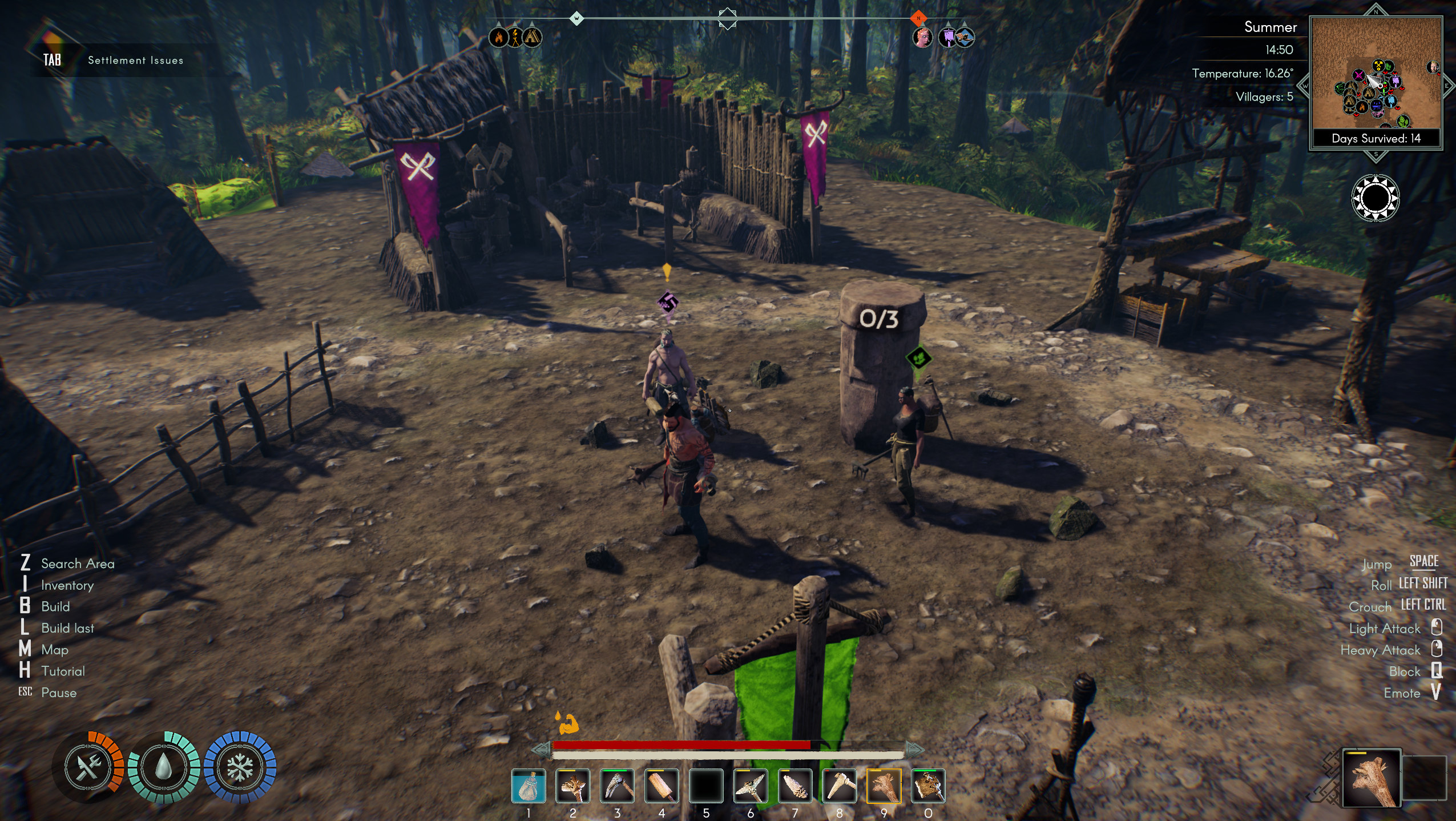
I want to be able to assign multiple jobs in priority order. A primary and secondary job would go a long way to making work management less tedious. It might be that once you get later into the game, having multiple jobs per villager isn’t needed. But I played for about 15 hours total and had six villagers and still spent a decent chunk of time unassigning and reassigning jobs.
That said, when you get it working without having to do anything for a few minutes, it’s remarkably satisfying. While my villagers scurry around doing their jobs, I’ll do things like mark the ground for leveling, lay the blueprints for new builds, and just generally manage and focus on growing the village. It’s a really great experience.
The final piece of village management that I find annoying is managing morale. Villagers will tell you what is negatively impacting their morale but not how to resolve it. The villagers’ morale will drop if you don’t have defenses, and silly me, I built fences thinking they would be defenses (they were not!). I had to build a watch tower and assign a villager to the watch tower to improve my defense score. My villagers complained about work hours, so I increased their leisure time on the schedule, to no effect. In fact, I never actually figured out how to make them happier about their work hours.
Finally, I want to touch on combat because while ASKA is not a game focused on fighting, it still offers combat systems. It’s pretty standard fare and isn’t substantially different than Valheim, just more forgiving. In my playtime, the undead attacked my village, and I accidentally stumbled across some wolves while I was wandering that decided I looked tasty. Most of my combat was spent defending my village from these giant rabbit/goat pests that will eat your village’s food if you don’t (constantly) scare them off. They will also do this annoying thing where they will dig through all of your various stores and dump things on the ground for funsies. My loathing of these beasts knows no limits.
Ultimately, there were more annoyances here than what I covered since this impressions piece is already pretty long. But ASKA is something special. It’s a surprisingly fun and rewarding experience even in early access. There isn’t another survival game out there quite like it, and I’m here for it. If you are looking for yet another place to smite your enemies and rush to finish (and invariably complain about the lack of content), you probably won’t enjoy ASKA. But if you like city builders, strategy games, and colony sims, this might be the colony-survival-builder for you.

